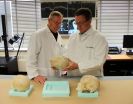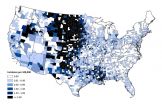(Press-News.org) This news release is available in Spanish.
Although the genetic blueprint of every cell is the same, each cell has the potential to become specific for a tissue or organ by controlling its gene expression. Thus, every cell "reads" or "switches on" a particular set of genes according to whether it should become a skin, heart, or liver cell. Launched by the National Institutes of Health (NIH) in 2010, the GTEx Project aims to create a reference database and tissue bank for scientists to study how genomic variants affect gene activity and disease susceptibility.
Following their two-year pilot study, GTEx scientists--including scientists from the CRG--have now published their initial results in three articles in the May 8 issue of Science. These breakthrough studies provide new insight into how genomic variants control the how, when, and how many aspects of genes being turned on and off in different tissues, and how this can predispose people to diseases such as cancer, heart disease, and diabetes.
One of these articles investigates the variation of gene expression between individuals and, in particular, between organs and tissues. This research was led by Dr. Roderic Guigó (coordinator of the Bioinformatics and Genomics Programme at the CRG and Professor at the UPF) and involved scientists from the Broad Institute (Harvard University and MIT, Cambridge, Massachusetts) "We realized that gene activity differed much more across organs or tissues than across individuals. Variation between individuals accounted only for about 5% of the total variation in gene activity," said Dr. Guigó.
Genes exhibiting high inter-individual expression variation are related to sex, ethnicity, and age. "We found differences linked to sex in more than 750 genes, with the vast majority in breast tissue. In the same way, gene expression differences between individuals with African or European roots are concentrated in the skin," said Dr. Pedro Ferreira, part of the CRG team and currently working at the Institute of Molecular Pathology and Immunology at the University of Porto (Portugal). "We also observed that there are about 2,000 genes, which would represent 10% of human genes, that vary with age, including genes related to neurodegenerative diseases such as Parkinson's disease and Alzheimer's disease", said lead author Dr. Marta Melé, part of the CRG team who is now working at the Harvard University.
The relationship between gene expression and tissue specificity was found to be less straightforward than expected. For example, considering that cells are more similar within each tissue type, scientists expected to find gene expression patterns that are tissue-specific. However, "even though tissues and organs have an specific gene expression pattern, we have found surprisingly few genes expressed exclusively in a particular tissue or organ", said Dr. Ferran Reverter, CRG researcher and lecturer at the University of Barcelona.
The GTEx project, a step forward to understanding the human genome
To set up the GTEx project, investigators collected more than 30 tissue types from autopsy or organ donations and tissue transplant programs and are analyzing both DNA and RNA from these samples. The project will eventually include tissue samples from about 1,000 deceased donors. The project is supported by the NIH Common Fund and administered by the National Human Genome Research Institute (NHGRI), the National Institute of Mental Health (NIMH), and the National Cancer Institute (NCI), all part of NIH.
"GTEx was designed to sample as many tissues as possible from a large number of individuals in order to understand the causal effects of genes and variants, and which tissues contribute to predisposition to disease," said Emmanouil Dermitzakis, Ph.D., professor of genetics at the University of Geneva Medical School, Switzerland, and one of the project leaders. "The number of tissues examined in GTEx provides an unprecedented depth of genetic variation. It gives us unique insights into how people differ in gene expression in tissues and organs from both genomic and environmental causes."
The GTEx resource is being developed in part to meet a growing scientific need. Scientists have used genome-wide association studies (GWAS) to study the roles that genomic variants play in disease. By comparing thousands of genomic variants in people with a disease to thousands without, they can associate genomic variants and regions in the genome with diseases. But these associations don't necessarily explain what specific genomic variants do or how they might affect the biology and development of disease. "GTEx data allow us to ask questions about genetic variation and its effects on gene expression both in one tissue and across many tissues that we simply couldn't ask before," said Dr. Kristin Ardlie, director of the GTEx Laboratory Data Analysis Center at the Broad Institute (Harvard University and MIT, Cambridge, Massachusetts).
The GTEx project would have not been possible without the generous participation of deceased donors who provided samples to this project. By 2015, the number of donors is expected to reach around 1,000, with about 20,000 tissue samples. In this sense, the GTEx project has also been a logistic challenge and one more example on the importance of social awareness to carry out a successful scientific research project.
INFORMATION:
CAMBRIDGE, Mass--Researchers have succeeded in creating a new "whispering gallery" effect for electrons in a sheet of graphene -- making it possible to precisely control a region that reflects electrons within the material. They say the accomplishment could provide a basic building block for new kinds of electronic lenses, as well as quantum-based devices that combine electronics and optics.
The new system uses a needle-like probe that forms the basis of present-day scanning tunneling microscopes (STM), enabling control of both the location and the size of the reflecting ...
For years, scientists have been puzzled by the presence of short stretches of genetic material floating inside a variety of cells, ranging from bacteria to mammals, including humans. These fragments are pieces of the genetic instructions cells use to make proteins, but are too short a length to serve their usual purpose. Reporting in this week's Cell, researchers at Rockefeller have discovered a major clue to the role these fragments play in the body -- and in the process, may have opened up a new frontier in the fight against breast cancer.
Specifically, Sohail Tavazoie ...
Every inch of our body, inside and out, is oozing with bacteria. In fact, the human body carries 10 times the number of bacterial cells as human cells. Many are our friends, helping us digest food and fight off infections, for instance. But much about these abundant organisms, upon which our life depends, remains mysterious. In research reported May 7 in Cell, scientists at Rockefeller finally crack the code of a fundamental process bacteria use to defend themselves against invaders.
For years, researchers have puzzled over conflicting results about the workings of a ...
EAST LANSING, Mich. - Much like a finger leaves its own unique print to help identify a person, researchers are now discovering that skull fractures leave certain signatures that can help investigators better determine what caused the injury.
Implications from the Michigan State University research could help with the determination of truth in child abuse cases, potentially resulting in very different outcomes.
Until now, multiple skull fractures meant several points of impact to the head and often were thought to suggest child abuse.
Roger Haut, a University Distinguished ...
PULLMAN, Wash.--Washington State University researchers say the popularity of bamboo landscaping could increase the spread of hantavirus, with the plant's prolific seed production creating a population boom among seed-eating deer mice that carry the disease.
Richard Mack, an ecologist in WSU's School of Biological Sciences, details how an outbreak could happen in a recent issue of the online journal PLOS One.
Bamboo plants are growing in popularity, judging by the increased number of species listed by the American Bamboo Society. Some grow in relatively self-contained ...
WASHINGTON -- Can a true, robust global health framework be created to help prevent tragedies like Ebola while at the same time allow countries to meet everyday health needs?
Georgetown University global health and law experts say it can be done, and in a special issue of "The Lancet" focusing on global health security, they propose specific priorities to transform a fragmented health system into a "purposeful, organized" framework with national health systems at its foundation and an empowered World Health Organization at its apex.
"The Ebola epidemic in west Africa ...
The west African Ebola epidemic has rekindled interest in global health security, but it has also highlighted a troubling lack of political commitment to public health, and it is far from clear whether the crisis will be enough to rejuvenate global health security, say leading global health experts writing in The Lancet.
Through a series of essays [1], the review, which is published as part of a special issue on global health security, explores different perspectives on the wider lessons that can be drawn from the outbreak, including how it has demonstrated the importance ...
Your genes may influence how sensitive you are to emotional information, according to new research by a UBC neuroscientist. The study, recently published in The Journal of Neuroscience, found that carriers of a certain genetic variation perceived positive and negative images more vividly, and had heightened activity in certain brain regions.
"People really do see the world differently," says lead author Rebecca Todd, a professor in UBC's Department of Psychology. "For people with this gene variation, the emotionally relevant things in the world stand out much more."
The ...
For faster, longer-lasting water filters, some scientists are looking to graphene --thin, strong sheets of carbon -- to serve as ultrathin membranes, filtering out contaminants to quickly purify high volumes of water.
Graphene's unique properties make it a potentially ideal membrane for water filtration or desalination. But there's been one main drawback to its wider use: Making membranes in one-atom-thick layers of graphene is a meticulous process that can tear the thin material -- creating defects through which contaminants can leak.
Now engineers at MIT, Oak Ridge ...
BOULDER--New research has identified correlations between weather conditions and the occurrence of West Nile virus disease in the United States, raising the possibility of being able to better predict outbreaks.
The study, by researchers with the National Center for Atmospheric Research (NCAR) and the Centers for Disease Control and Prevention (CDC), finds strong correlations across much of the country between an increased occurrence of West Nile virus disease and above average temperatures in the preceding year. The scientists also find that precipitation influences ...

